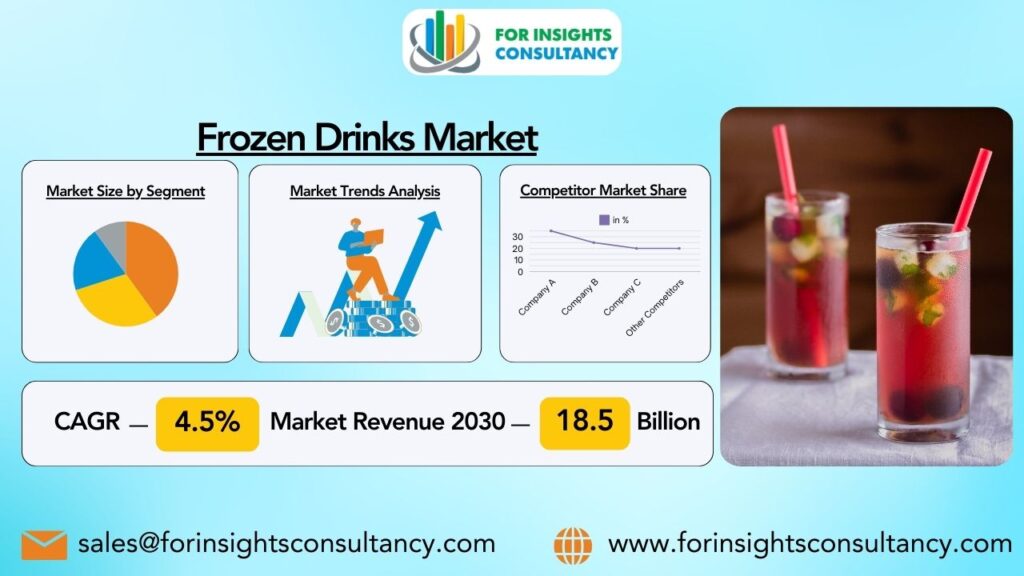Aug-2024 Formats | PDF | Category: Food Beverages | Delivery: 24 to 72 Hours
Frozen Drinks Market Growth in Upcoming Years
Frozen Drinks Market is anticipated to grow rapidly at 4.5% CAGR accordingly, it will grow from its existing size of from $13.6 Billion in 2023 to $18.5 Billion by 2030.
The frozen drinks Market is poised for significant growth in the forthcoming times, driven by consumers’ adding preference for accessible and stimulating potables. Demand for frozen amalgamations, smoothies, and slushies is anticipated to rise as people seek new and delectable options to quench their thirst and beat the heat.
One crucial factor contributing to the Market’s growth is the growing fashion ability of frozen drink machines in marketable settings similar as caffs, bars, and cafes. These machines make it easy for businesses to offer a wide variety of frozen potables, attracting companies and driving deals.
also, the trend towards healthier and natural constituents in frozen drinks is anticipated to drive invention in the Market. Consumers are decreasingly looking for drinks made with real fruits, natural sweeteners, and organic constituents, creating openings for brands to feed to this demand and separate themselves in the competitive Market.
Overall, with adding disposable inflows, changing consumer preferences, and innovative product immolations, the frozen drinks Market is set to witness robust growth in the forthcoming times, presenting instigative openings for both being players and new entrants in the industry.
The frozen drinks market is thriving, driven by consumers’ growing desire for refreshing, convenient beverages. From frozen cocktails to icy smoothies, the market offers a diverse range of options for all ages.
Key factors propelling growth include the popularity of ready-to-drink frozen cocktails and the demand for premium, artisanal flavors. Advanced technology has enhanced the taste and texture of these drinks, further driving consumer appeal. Wide distribution channels and strategic marketing, including seasonal promotions, contribute to market expansion.
While challenges such as supply chain logistics exist, the overall market is poised for continued growth due to consumers’ increasing preference for indulgent and refreshing beverages.
The Frozen Drinks Market has had a significant impact on different industry, ranging from food and beverage to hospitality and entertainment. With the growing demand for innovative and stimulating frozen potables, there has been a swell in new product immolations and collaborations among colorful companies. This trend has led to increased competition and Market growth, with businesses seeking to separate themselves through unique flavors, sustainable practices, and accessible packaging results. The fashion ability of frozen drinks has also created new openings for suppliers of frozen fruits, authorities, and outfit, stimulating profitable growth and job creation in these sectors. Overall, the frozen drinks demand continues to drive invention and consumer engagement across a wide range of industry.
Frozen Drinks Market Trends 2025
The frozen drinks market is experiencing dynamic growth fueled by evolving consumer preferences. A focus on health and wellness is driving demand for nutritious and functional options, while a desire for indulgent experiences is fueling the premium segment.
Consumers seek convenience and innovation, leading to a surge in ready-to-consume formats and exciting flavor combinations. As sustainability becomes increasingly important, brands are adopting eco-friendly practices. Overall, the market is characterized by a blend of health, indulgence, and convenience.
Frozen Drinks Market Dynamics
Growth Drivers
Consumer Demand and Lifestyle Shifts
The surging popularity of frozen beverages is primarily driven by contemporary consumer preferences. The fast-paced lifestyle has fueled demand for quick and convenient drink options, with ready-to-consume and easily prepared frozen beverages leading the charge. Moreover, consumers increasingly seek out novel and indulgent experiences, leading to a proliferation of innovative flavors and customizable options.
Market Expansion and Growth Catalysts
The beverage industry has responded to these trends by expanding its offerings. Cafés, coffee shops, restaurants, and bars now feature a diverse range of frozen drinks, from classic smoothies to elaborate cocktails. Additionally, the emphasis on health and wellness has given rise to nutritious frozen options fortified with vitamins, proteins, and superfoods. Seasonal promotions and technological advancements in blending, freezing, and packaging have further propelled market growth.
Challenges and Restraints
Despite the promising outlook, the frozen beverage market faces several challenges. Health concerns, particularly regarding sugar and calorie content, as well as allergen considerations, can hinder consumption. The seasonal nature of the product, coupled with economic fluctuations, can impact sales. Intense competition, market saturation, and the complexities of storage, distribution, and regulatory compliance also pose significant hurdles.
The frozen beverage market is characterized by dynamic consumer preferences and industry innovations. To thrive, businesses must address the challenges posed by health concerns, seasonality, and market competition while capitalizing on the demand for convenience, indulgence, and health-focused options.
Frozen Drinks Market Segment Analysis
The frozen drinks market is thriving, driven by consumer demand for refreshing and convenient beverages.
Overall, the frozen drinks market is characterized by product diversity, expanding distribution, and evolving consumer preferences, reflecting broader trends towards convenience and indulgence.
By Type
- Alcoholic Drinks
- Non-alcoholic Drinks
By Application
- Hypermarket & Supermarket
- Food & Drink Specialists
- Convenience Stores
Competitive Landscape of the Frozen Drinks Market
The frozen beverage market is a dynamic segment encompassing a wide range of products, from coffee-based drinks to alcoholic cocktails and fruit-based slushies.
Key Players
- Coca Cola
- RedBull
- DESHI
- Kraft Foods
- Nestle
- Pepsico
- ABInbev
- Unilever
- Heineken Brouwerijen
- LACTALIS
- Coca Cola
- Diageo
- General Mills
- Tsingtao
- Mengniu
New Developments
23 June – Unilever announced it has signed an agreement to acquire personal care brand Dr. Squatch from growth equity firm Summit Partners. This complementary acquisition marks another step in expanding Unilever’s portfolio towards premium and high growth spaces.
Sept. 17, 2024 The Coca‑Cola Company and Bacardi Limited Announce Plans to Debut BACARDÍ & Coca‑Cola Ready-To-Drink Cocktail
Frozen Drinks Market Regional Outlook
North America
The North America firmed drinks Market is witnessing significant growth due to the rising demand for convenience potables and innovative flavors. In the United States, the Market is driven by the fashionability of frozen amalgamations and smoothies, with consumers seeking stimulating and indulgent options. The rapid-fire expansion of cafes and specialty drink stores offering frozen potables is also contributing to Market growth.
In Canada, consumers are decreasingly concluding for healthier firmed drink options, similar as fruit- grounded smoothies and low- sugar slushies. The Market is characterized by a preference for natural and organic constituents, driving invention in product phrasings.
In Mexico, the frozen drinks Market is passing a swell in demand for traditional frozen potables like aguas frescas and horchata, alongside ultramodern frozen creations inspired by transnational trends. The tropical climate in numerous regions of Mexico also boosts the fashionability of frozen drinks as a way to cool down and stay refreshed. Overall, the North American firmed drinks Market is dynamic and evolving, feeding to a wide range of consumer preferences and tastes.
Europe
The frozen drinks Market in Europe is witnessing significant growth driven by the adding demand for stimulating and accessible potables. In Germany, firmed drinks are popular during the summer months, with flavors like strawberry, mango, and tropical fruits being the pets among consumers. The Market in France is characterized by a growing trend of decoration firmed amalgamations in bars and caffs, with a focus on unique flavor combinations and high- quality constituents.
In the United Kingdom, firmed drinks are decreasingly being offered in cafes and specialty libation shops, feeding to a youthful and health-conscious demographic. Spain’s Market for frozen drinks is told by the country’s vibrant escapism culture, with firmed margaritas and daiquiris being popular choices in bars and clubs.
Asia pacific
Asia Pacific is a region with a different Market for frozen drinks, with each country offering unique openings and challenges. In China, the frozen drinks Market is driven by the adding fashion ability of bubble tea and fruit- grounded smoothies among the youngish population. The growing urbanization and changing consumer preferences are fueling the demand for innovative frozen drink flavors and textures in Japan. South Korea stands out for its dynamic cafe culture, with frozen coffee drinks like frappes gaining traction among consumers seeking convenience and variety.
India’s frozen drinks Market is witnessing rapid-fire growth, driven by the rising disposable income and changing cultures of the civic population. The demand for healthy and natural constituents in frozen potables is on the rise in Australia, reflecting a shift towards clean marker products. In Indonesia, the Market for frozen drinks is expanding due to the flourishing foodservice assiduity and adding consumer spending on indulgent treats. Overall, the Asia Pacific region presents a vibrant geography for the frozen drinks Market, with each country offering distinct openings for growth and invention.
Middle east
The frozen drinks Market in the Middle East region is passing significant growth due to the rising demand for accessible and stimulating libation options in hot climates. Countries similar as Saudi Arabia, UAE, Qatar, and Kuwait are leading the Market in this region.
Saudi Arabia With a hot climate throughout the time, Saudi Arabia has a high demand for frozen drinks. The Market is driven by the adding urbanization, changing cultures, and a growing youthful population who seek innovative libation options.
UAE The firmed drinks Market in the UAE is thriving, fueled by the presence of a large aboriginal population and a vibrant tourism assiduity. The country offers a different range of firmed potables feeding to different tastes and preferences.
Qatar is witnessing a growing trend towards healthier firmed drink options, with a focus on natural constituents and low sugar content. The Market is driven by a rising mindfulness of health and heartiness among consumers.
Kuwait, the frozen drinks Market is roaring, supported by the growing foodservice assiduity and a strong culture of eating out. The Market is characterized by a variety of flavors and blends to feed to the different preferences of consumers.
Frequently Asked Questions:
What is the current size of the Frozen Drinks market?
Frozen Drinks Market is expected to grow rapidly at 4.5% CAGR consequently, it will grow from its existing size of from $13.6 Billion in 2023 to $18.5 Billion by 2030.
Who are the major players in the Frozen Drinks Market?
The leading Players in the market are Coca Cola, RedBull, DESHI, Kraft Foods, Nestle, Pepsico, ABInbev, Unilever, Heineken Brouwerijen, LACTALIS, Coca Cola, Diageo, General Mills, Tsingtao, Mengniu, Yili.
Which segments are covered in the report of Frozen Drinks Market?
The Frozen Drinks Market is Segmented On The Basis Of Type, Application, And Geography.
Which regions are covered in the report that having a potential scope for the Frozen Drinks Market?
On the basis of Geography, The Frozen Drinks Market is classified into North America, Europe, Asia Pacific, and the Rest of the world.
Key Benefits to Stakeholders:
· This study offers a quantitative examination of Frozen Drinks Market trends, estimations, and dynamics from 2025-2030 to identify potential opportunities in this space.
· Porter’s five forces study emphasizes the value of buyers and suppliers in helping stakeholders to make profitable business decisions while expanding their network.
· Undergoing in-depth analyses on market size and segmentation is vital in identifying current Frozen Drinks Market opportunities.
· Each region’s largest countries are mapped according to their revenue contribution for an accurate picture of this global industry.
· The Frozen Drinks Market research report offers a thorough examination of its major players. As such, purchasing this report provides many advantages to any organization looking to enter this competitive industry.
Reasons to Purchase Frozen Drinks Market Report:
- Current and Future Prospects of Frozen Drinks Market in both developed and emerging markets.
- Porter’s Five Force Analysis to help analyze various perspectives within this market. Major regions should experience rapid increases during this time.
- Uncover the most up-to-date industry developments, Frozen Drinks Market shares, and top market players’ strategies.
Strategic Benefits for Decision-Makers:
· CEOs and executives seeking rapid market penetration
· Investors targeting high-ROI sectors
· Sales leaders pursuing contract wins in growth regions
· Product managers launching into high-demand categories
Key Strategic Tools Included:
· Forecast-based decision modeling through 2030
· Porter’s Five Forces for competitive advantage
· Benchmarking matrix for top players
· policy impact analysis
This is not just a market report – it is a competitive acceleration tool built for the urgency and complexity of the business environment.
Any Requirement Contact us: https://forinsightsconsultancy.com/contact-us/
Table of Contents
- Market Overview
- Market Size and Growth Rate: Historical data and future growth forecasts for the frozen drinks market.
- Market Segmentation by Type: Breakdown by product type (e.g., Frozen Cocktails, Frozen Coffee Drinks, Frozen Fruit Drinks, Slushies).
- Market Segmentation by Distribution Channel: Breakdown by sales channel (e.g., Supermarkets, Convenience Stores, Online Retailers, Foodservice).
- Regional Market Analysis: Market size and growth rates by region (e.g., North America, Europe, Asia-Pacific, Latin America).
- Consumer Demographics and Preferences
- Demographic Breakdown: Age, gender, income levels, and other demographics of frozen drinks consumers.
- Consumer Preferences and Trends: Popular types and flavors, packaging preferences.
- Buying Behavior: Frequency of purchase, average spend per purchase.
- Factors Influencing Purchase Decisions: Price sensitivity, brand loyalty, quality, convenience.
- Competitive Landscape
- Key Market Players: Major brands and companies in the frozen drinks market.
- Market Share of Top Competitors: Share of major players in the market.
- Competitive Strategies: Marketing, distribution, and product strategies of key players.
- SWOT Analysis: Strengths, weaknesses, opportunities, and threats for leading competitors.
- Product Analysis
- Types of Frozen Drinks: Detailed analysis of various types such as frozen cocktails, frozen coffee drinks, frozen fruit drinks, slushies.
- Ingredients and Formulations: Common ingredients and innovations in formulations.
- Product Innovations: New product developments and trends.
- Quality Differentiation and Price Range: Analysis of quality and pricing tiers.
- Distribution Channels
- Overview of Distribution Channels: Breakdown of retail and online sales channels.
- Sales Performance by Channel: Revenue and growth rates by distribution channel.
- Trends in Distribution: Changes and trends in distribution methods and logistics.
- Pricing Analysis
- Average Pricing: Pricing data for different types of frozen drinks.
- Pricing Strategies: Strategies used by major brands and their impact.
- Impact of Pricing on Consumer Behavior: How pricing affects purchasing decisions.
- Marketing and Promotion
- Marketing Strategies: Approaches used by brands to market their products.
- Promotional Tactics: Advertising, discounts, and other promotional activities.
- Effectiveness of Marketing Campaigns: Analysis of successful marketing strategies.
- Regulatory Environment
- Regulations Affecting Production and Sales: Compliance requirements for ingredients, labeling, and packaging.
- Impact of Regulations: How regulations affect market dynamics and product offerings.
- Financial Performance
- Revenue and Profit Margins: Financial performance of major companies.
- Market Revenue Forecasts: Future revenue projections for the market.
- Investment and Funding Trends: Investment patterns and funding trends in the sector.
- Market Trends and Future Outlook
- Emerging Trends: New trends shaping the frozen drinks market.
- Consumer Trends: Shifts in consumer preferences and behaviors.
- Projected Market Growth: Future growth opportunities and market dynamics.
- Challenges and Opportunities
- Key Challenges: Challenges faced by the market and individual companies.
- Opportunities for Growth: Potential areas for expansion and innovation.
- Risks and Mitigation Strategies: Risks associated with the market and strategies to address them.
- Supply Chain Analysis
- Supply Chain Overview: Key components and stages in the supply chain.
- Key Suppliers and Raw Materials: Analysis of major suppliers and raw materials used in production.
- Supply Chain Risks: Risks and challenges in the supply chain.
- Production and Manufacturing
- Production Processes: Overview of production processes for frozen drinks.
- Key Manufacturing Facilities: Major production facilities and their locations.
- Technological Innovations: Advances in production technology.
- Trade and Export Analysis
- Major Exporting and Importing Countries: Key players in international trade of frozen drinks.
- Trade Agreements: Impact of trade agreements on the market.
- Export Trends and Trade Barriers: Trends in exports and barriers to trade.
- Consumer Insights
- Focus Groups and Surveys: Results from consumer research studies.
- Brand Loyalty and Preferences: Insights into consumer loyalty and brand preferences.
- Factors Influencing Purchase Decisions: Detailed analysis of factors driving consumer choices.
- Environmental and Sustainability Factors
- Environmental Impact: Impact of production on the environment.
- Sustainability Practices: Sustainable practices adopted by companies.
- Consumer Attitudes Toward Sustainability: How sustainability concerns affect consumer choices.
- Competitive Benchmarking
- Comparative Analysis: Comparison of leading brands based on features, quality, and market performance.
- Feature and Quality Benchmarks: Standards for product quality and features.
- User Ratings and Reviews: Analysis of consumer feedback and ratings.
- Innovation and R&D
- Current Innovations: Latest innovations in frozen drink products and processes.
- R&D Investments: Investments in research and development.
- Future Directions: Emerging technologies and future trends in the sector.
Select PDF License
Single User: $3499
Multiple Users: $4499
Corporate Users: $5499








